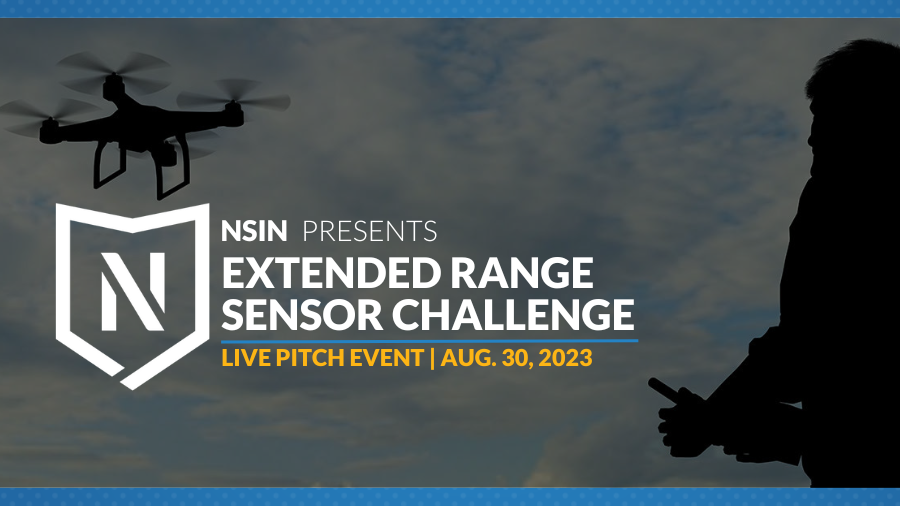
NSIN Presents: Extended Range Sensor Challenge -
Apply by Aug. 4, 2023

Overview
The National Security Innovation Network (NSIN), in partnership with 1st Multi-Domain Task Force (1MDTF), will run a pitch challenge called NSIN Presents: Extended Range Challenge to identify capabilities to exercise extended range sensing capabilities to characterize the operational environment in order to enable joint freedom of action.
The 1MDTF is making significant investments in the arena of extended range sensing capabilities and seeks to support the growth of sensing technologies in startups that can support various defense applications for the U.S. Department of Defense (DoD) with a pitch challenge including $75,000 in awards.
A team of subject matter experts will evaluate applicants and select up to the top 15 companies as finalists for participation in the hybrid Pitch Day in August 2023. A total of $75,000 in awards will be awarded to the top performing company/companies.
The final live pitch event will include a hybrid format (in-person and virtual) event for participants and interested innovators from the Pacific Northwest Mission Acceleration Center (PNW MAC) in Seattle, WA.
The Challenge
The 1st Multi-Domain Task Force (1MDTF), seeks to identify capabilities to exercise Extended Range Sensing capabilities to make sense of the operational environment in order to enable joint freedom of action. 1MDTF must be able to sense extensively and persistently across strategic distances in both exercises and operational scenarios. The problem lies in how and what sensors to employ that can enable joint freedom of action and observe any multi domain effects on the adversary. Section 848 compliance will be required for any work with the DoD resulting from the competition or otherwise.
Technology Description
The technology must have three mechanisms to meet the experimental objectives for 1MDTF. The technology must be high in endurance with the ability to remain in persistent contact that is maneuverable from a remote location. The second capability required is the technology must be able to carry tailorable and scalable payloads capable of sensing. Lastly, it must have a mechanism where it would allow feedback of data through transportation back to Command and Control.
The High Altitude Balloons were hosted by Headquarters, Department of the Army Intelligence Section Intelligence Surveillance and Reconnaissance task force ( HQDA G2 ISR task force) and were a good first step in the above listed concepts. They were able to stay high in endurance with different payloads that gave feedback through transport to our command node.
The capabilities would ideally combine to enable sensors to give data to the kill web concept and federate data to joint and combined partners for target adjudication.
The U.S. Army is seeking capabilities that enable persistent sensor capabilities in the INDOPACOM AOR with the following feature requirements.
Required:
- Self powered
- Long endurance (2+ weeks)
- Capable of carrying customizable payloads up to 7 lbs. (higher preferred)
- TRL 6 or higher
- Capable of live data backhaul
- Capable of short takeoff/landing operations (from unimproved surfaces preferred)
Desired:
- Software Defined Radios MANET (MUOS, SILVUS)
- Common Operational Tool suites (AIMES, BlueEye)
- Able to send data to classified network
- Satellite Communications
- Can carry EO payloads
- Can carry IR payloads
- Can carry MASINT payloads
- Programmable for autonomous flight
- Programmable for in-flight routing by machine learning
- Small signature (through size, altitude, or profile) to enable survivability
- Capable of expeditionary launch and recovery operations (small space, few people)
- Performance is robust against weather conditions
- Mod-Payload compliant (SOCOM-developed standard for payload integration)
- End-User: Multi-Domain Effects Battalion, Extended Range Sensing and Effects Company
Benefits of Participating
- $75,000 in awards to the top performing company/companies
- Exposure to leaders across multiple branches of the U.S. Department of Defense (DoD)
- Potential for follow-on opportunities such as Other Transaction Agreements (OTAs), Cooperative Research and Development Agreements (CRADAs), and others
Eligibility
- U.S. Owned and Operated Startups, or
- Early-Mid Stage Ventures (i.e., little to no DoD contracts, equal to or earlier than Series A); OR non-traditional defense contractors
- With the ability to demonstrate the solution’s capabilities by August 2023
Watch the Ask Me Anything
Timeline
- June 27, 2023: Solicitation Opens
-
July 7, 2023: “Ask Me Anything” Session Register via ZoomGov - Aug. 4, 2023: Solicitation Closes & Down-selection Begins
- Aug. 18, 2023: Finalists Announced
- Aug. 24, 2023: Pitch Rehearsal
- Aug. 30, 2023: Live Pitch Event at the PNW MAC in Seattle, WA
- Week of Sep. 4, 2023: Winner Announced
Access Extended Range Sensor Challenge
The application period for this opportunity is now closed. To remain up-to-date with opportunities to attend future NSIN events, please subscribe to our newsletter or follow us on LinkedIn.
Judging Criteria
Applications and Pitches will be judged on six major criteria:
- Technical: Soundness, technical merit, innovation of proposed approach, and feasibility of the proposed solution.
- Team: Qualifications of proposed principals, support staff, and consultants.
- Commercialization: Company has a technology solution that is viable in non-defense markets.
- Quality of Pitch: Company presents a clear and concise overview of its company and technology, demonstrates how its technology solves one or more of the defined problem areas, and effectively answers questions from strategic advisors.
- Operational Effectiveness: Proposed solution aligns with listed features
- Cost: Forecasted costs of proposed solution are feasible for adoption by 1MDTF, USARPAC, and the Army, with scalable costs beginning at 2 million
Background Information
The 1st Multi-Domain Task Force operates in the Pacific to have persistent contact with the adversary. One of the challenges associated with operating in the Pacific is the wide physical range that needs to be sensed through ISR or EO/IR sensors. High Altitude Balloons were used historically to limited success. Experimentation with High Altitude Balloons and various UAV’s did not have the needed terrestrial/aerial assets that provide persistent detection across domains at ranges 300km+, integrated into the space layer of ISR.
About USARPAC
U.S. Army Pacific contributes to a ‘Free and Open Indo-Pacific’ by leading multi-domain transformation and applying landpower to maximal effect in the most consequential region for America’s future. U.S. Army Pacific provides the Joint Force with decisive integrated landpower to consolidate gains across a joint campaign to deter, transition, and respond to natural and manmade crises, and prevail in conflict.
About National Security Innovation Network
NSIN is a program office in the U.S. Department of Defense, nested within the Defense Innovation Unit (DIU). We are set up to collaborate with a wide variety of innovators to include universities, researchers, students, entrepreneurs and start-ups. We create opportunities for collaboration across communities and connect those that might not traditionally work in national security. Together, we help drive national security innovation and develop technologies that directly support the individuals responsible for protecting our country.
About the Mission Acceleration Center
The Mission Acceleration Center or MAC is an open door to the DoD Innovation ecosystem. It is a physical instance of the nationwide NSIN network. This program serves as a catalyst for a diverse population to develop actionable solutions to current and future warfighters’ most complex and pressing problems.
About the Pacific Northwest Mission Acceleration Center
The PNW MAC™’s goal is to remove barriers to engagement and accelerate defense innovation, serving as the center of gravity for the Pacific Northwest startup and venture communities, academia, and local and federal partners, to support the Department of Defense. Launching with Navy Tech Bridge, National Security Innovation Network (NSIN), Impact Washington, and Pacific Northwest Defense Coalition (PNDC) support, this community will allow for both formal collaboration and the serendipitous innovation or “coffee pot collaboration” that comes from bringing people together.
Partners

.png)